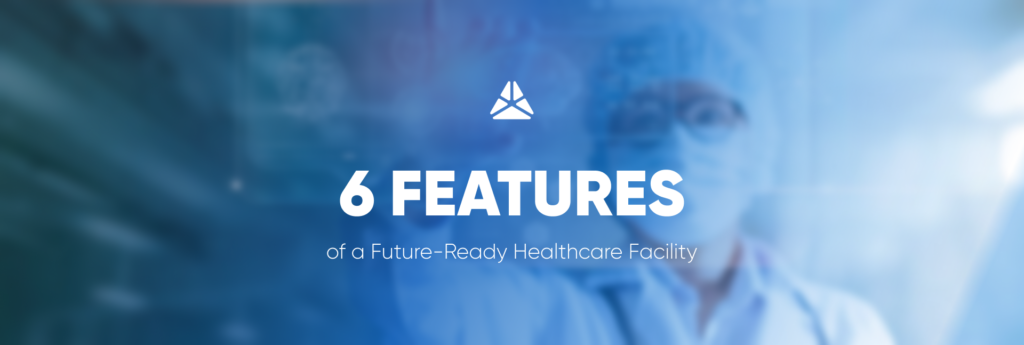
Today, digital innovation is crucial for future-ready medical facilities to provide adequate services to patients and IT outsourcing is a proven means to achieve that. We observe how many industries around us rapidly change and introduce innovation to their daily processes. In this regard, healthcare seems to lag behind others: 99% of organizations in the sector recognize the value of digital transformation, but only 12% are fully digital, according to Salesforce.
So, what is holding healthcare back from providing better patient experience?
The obvious reasons include the high cost of transformation and a lack of internal capacities to implement necessary innovations. This article will tell you how healthcare IT outsourcing helps medical facilities to achieve six features necessary to be considered future-ready.
Digital Transformation in Healthcare: Where Are We Now?
As healthcare providers aim to streamline their operations, optimize service delivery, and enhance patient outcomes, technology is becoming increasingly integrated throughout the entire healthcare value chain. Since 2020, there has been a significant increase in the proportion of healthcare and life sciences authorities who view digital solutions as a critical means of achieving a competitive edge.
Technology transformation can shape future-ready healthcare in several ways:
- Healthcare technology can automate administrative tasks, reduce paperwork, and streamline operations. With its potential to decrease administrative costs, which represent approximately a quarter of the nearly $4 trillion spent on healthcare in the United States each year, technology is well positioned to revolutionize the healthcare industry, says Salesforce.
- Healthcare technology also has the potential to improve the quality of patient care by providing clinicians with real-time data and insights that can inform their decision-making.
- What’s more important, innovations can help healthcare providers to make more accurate diagnoses, identify potential health risks, and develop personalized treatment plans.

Image by pch.vector on Freepik
- Innovations can help healthcare providers to manage patient data more efficiently and securely. Electronic health records (EHRs), for example, allow healthcare providers to access patient records from anywhere, at any time, and share information with other providers as needed.
- Finally, technology can empower patients to take an active role in their healthcare by providing them with access to their health information, educational resources, and tools for self-management.
A new report by Grant Thornton Bharat and the Association of Healthcare Providers delves into the perspectives of healthcare providers and practitioners on leveraging technology at critical touchpoints, as well as their preferences, challenges, and outlook. The report, which surveyed over 50 healthcare leaders and professionals from hospitals of various sizes, specialties, and locations, emphasizes that technology will play a vital role in enhancing accessibility, availability, and affordability of healthcare worldwide.
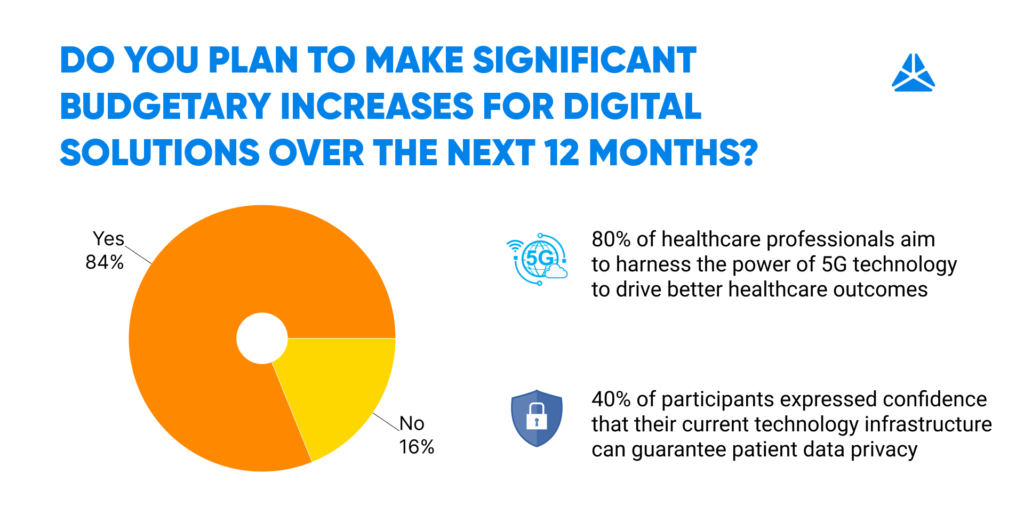
Source: Grant Thornton Bharat and the Association of Healthcare Providers Report
Statistically, it is expressed as follows: 84% of healthcare professionals plan to make significant budgetary increases for digital solutions over the next 12 months, while 80% aim to harness the power of 5G technology to drive better healthcare outcomes. Additionally, 40% of participants expressed confidence that their current technology infrastructure can guarantee patient data privacy. The survey also found that over half of the respondents observed operational efficiency improvements of up to 20% by investing in technology.
6 Features of a Future-Ready Healthcare Facility
Thus, what’s the features of a future-ready digital health company? To summarize everything above, these features include the ability to leverage data analytics, prioritize user experience, embrace interoperability, adopt emerging technologies, and prioritize healthcare cybersecurity. By embracing these features, digital health companies can position themselves for success in a rapidly changing industry, and ultimately improve the quality of patients’ care.
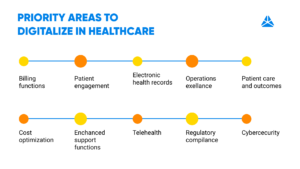
1. Improved Patient-Provider Communication
Transparent communication refers to the use of all those tools that simplify and automate communication between a medical institution and a patient. Transparent communication is a critical feature of a future-ready healthcare company as it builds trust, ensures compliance, and fosters innovation in the medical facility. For example, when the medical facility is transparent about how it collects, stores, and uses personal health information, customers are more likely to feel confident about using the company’s products and services. These facilities are more likely to be compliant with regulations such as HIPAA (Health Insurance Portability and Accountability Act). And last but not least, transparent communication helps to reduce confusion among patients and elevate their customer experience with the services.
2. The Shift of the POC Towards Home Care
The pandemic has accelerated the adoption of telemedicine. Since the outburst of COVID-19, patients often prefer receiving medical care in the comfort of their own homes rather than traveling to a medical facility. Since then, various healthtech players have entered the market and multiple hospitals have launched their telemedicine platforms.
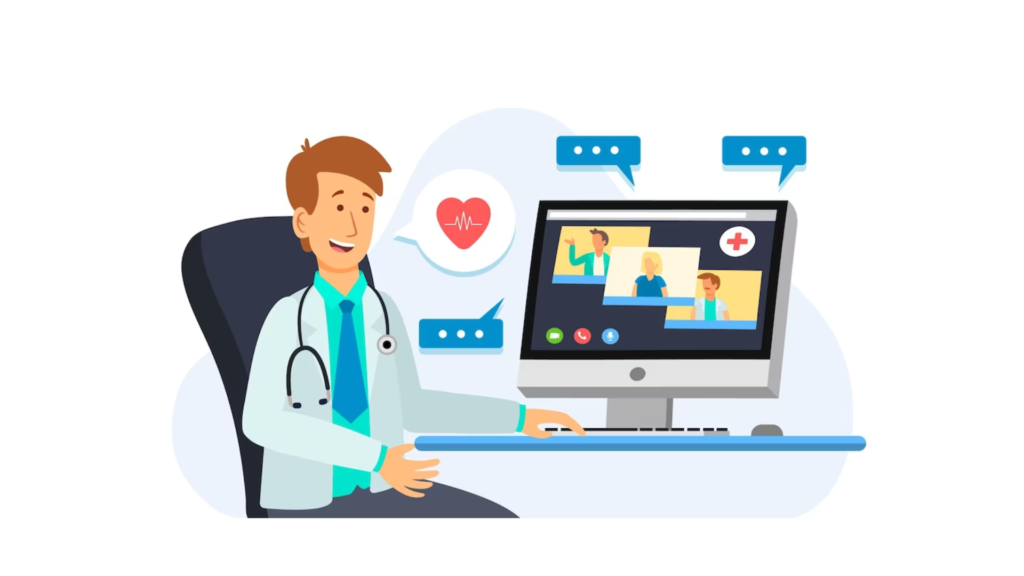
Advances in healthcare technology, such as telemedicine and remote patient monitoring, have made it possible to provide high-quality medical care in patients’ homes. This has made home-based care a more viable option for many patients. 80% of them say they want access to remote patient monitoring. McKinsey forecasts that, in the future, 25% of outpatient services could be conducted through telemedicine.
3. Introduction of EHR (Electronic Health Record) Systems
It happened so that doctors spend a considerable amount of time on paperwork and because of that often dedicate less time to their patients. One study found that technology enthusiasts in healthcare spend almost half as long on administrative work as others do. Thus, new technologies that facilitate the routine tasks of medical professionals will need to be adopted within future-ready hospitals.
For example, EHR (Electronic Health Record) systems automate many of the administrative tasks involved in patient care, such as record-keeping and appointment scheduling, freeing up healthcare providers’ time and resources to focus on patient care. EHR systems also enable better coordination and communication among healthcare providers, allowing them to share patient information and collaborate on treatment plans, leading to better health outcomes.
Although most hospitals now rely on electronic health record (EHR) systems, this still does not relieve physicians of the burden of routine tasks. Therefore, a promising alternative to manual data entry into the EHR is voice-to-text technology, which is expected to become widely used in the near future.
4. Extensive Use of AI in Decision-Making
AI is the foundation of all changes that happen in healthcare in this decade and a top feature of future-ready medical facilities. Innovators in the technology realm utilize cutting-edge tools like machine learning-powered AI and speech recognition to capture information directly at the point of care, resulting in a 45% reduction in documentation time for healthcare providers.
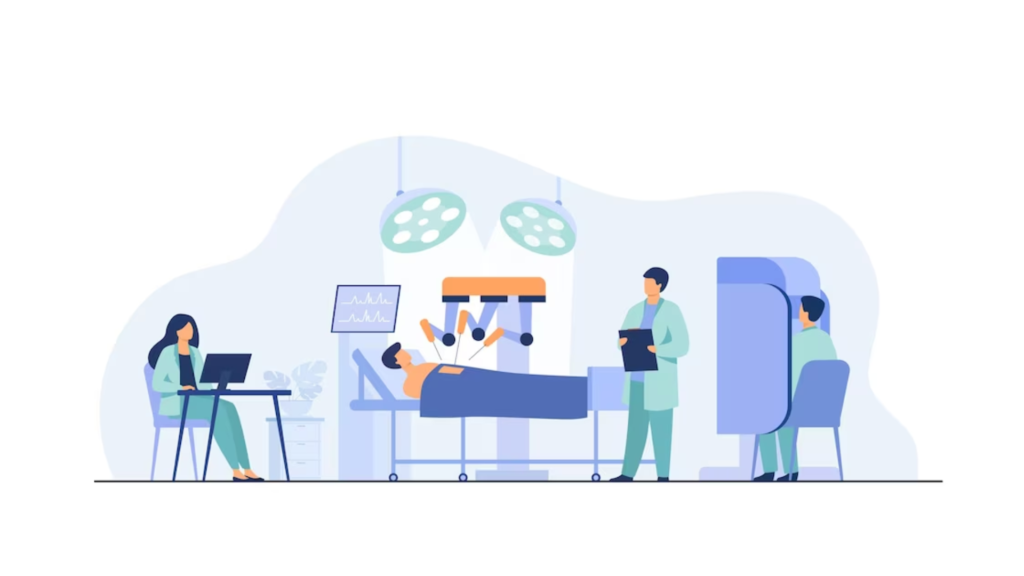
One of the most obvious benefits of AI introduction is more precise diagnosis and treatment. AI can analyze vast amounts of patient data to identify patterns and make predictions about patient health, leading to more accurate diagnoses and personalized treatment plans.
AI also provides predictive healthcare analytics that can identify patterns and even foresee future health risks, enabling healthcare providers to intervene early and prevent health conditions more effectively.
5. Advanced Healthcare Cybersecurity and Healthcare Data Management
The hospital database contains confidential patient information, including medical diagnoses, treatment records and insurance information which poses serious data exposure threats. Thus, solid healthcare data management in place is always crucial. Technological progress introduces the process of encryption into the operational systems of clinics. In turn, the process of converting plain text data into an encoded format ensures better protection of patient data. Hospitals can also use firewalls to protect their network and data from external threats such as malware and hacking attempts.
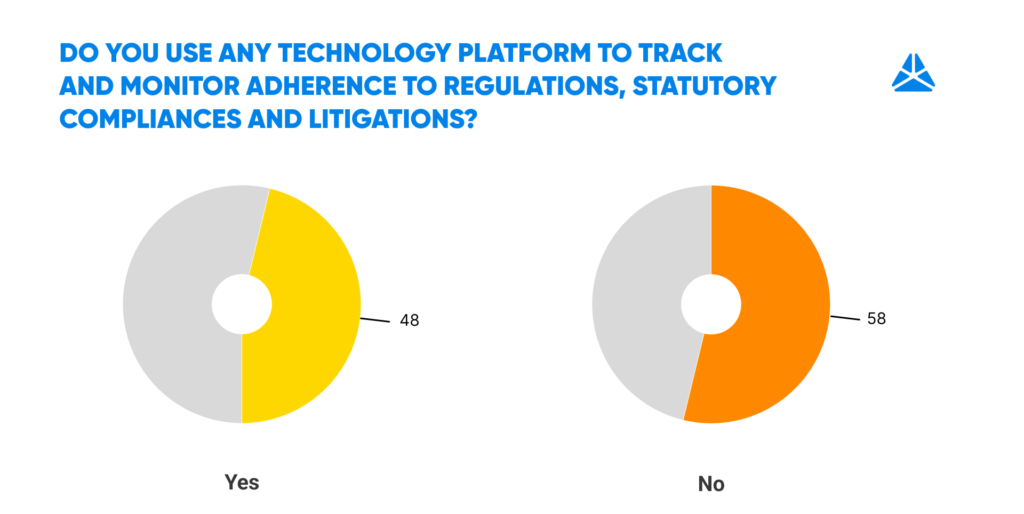
Source: Grant Thornton Bharat and the Association of Healthcare Providers Report
With the help of cloud computing, hospitals can also implement access controls such as user authentication and role access to ensure that only authorized individuals can approach patient data. As a result, healthcare providers can assess compliance status and risk levels faster than a manual compliance management system.
6. Transparent Process of Payment and Invoicing
The implementation of a smart and integrated EMR system has the potential to significantly improve billing processes and elevate the overall patient experience. This assertion is reinforced by survey findings which indicate that 54% of respondents currently do not have an EMR system integrated with their billing systems.
Furthermore, the survey highlights that the absence of EMR systems is hindering the widespread adoption of telemedicine. As a result, the full potential of EMRs in facilitating telemedicine remains largely untapped while transparent payment systems could:
- Provide patients with a clear understanding of the costs associated with their medical treatment. This transparency builds trust and confidence in the medical facility, improves patient satisfaction, and ultimately enhances the overall patient experience.
- Help to reduce billing errors, which are a common cause of patient frustration and administrative burden.
Overall, smooth payment systems and invoicing can help medical facilities to manage their finances more effectively.
How is the Healthcare Industry Benefiting from IT Outsourcing?
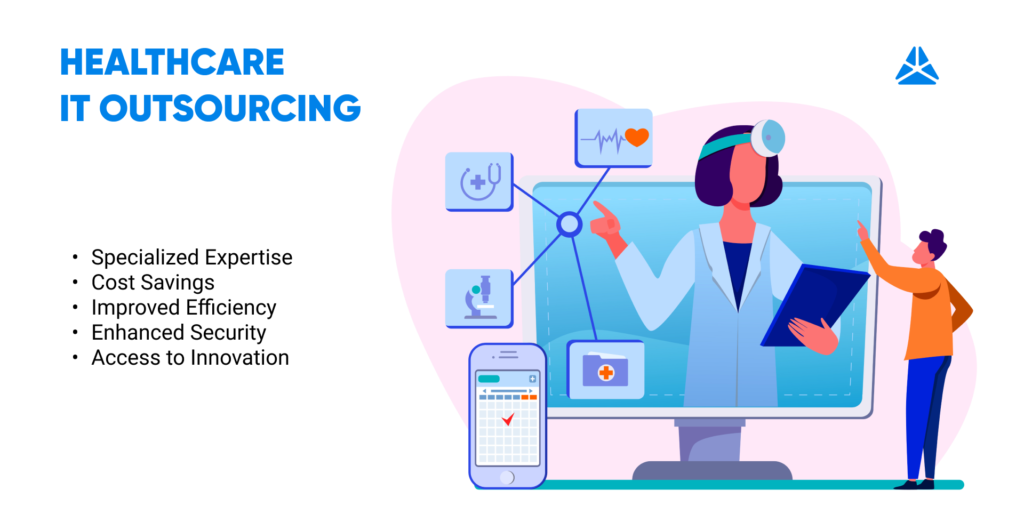
Above all, IT outsourcing can help healthcare organizations access new technologies and innovations that they may not have been able to afford or develop in-house. These companies can help healthcare organizations adopt innovative solutions that can improve patient care and outcomes, such as telemedicine, remote patient monitoring, and data analytics.
Additionally, outsourcing IT services can free up healthcare organizations’ internal resources, allowing them to focus on core business functions and strategic initiatives, including innovation. By partnering with IT outsourcing companies, healthcare organizations can leverage:
- Specialized Expertise: Healthcare IT outsourcing companies have specialized expertise and knowledge in healthcare IT systems, medical devices, and regulatory compliance.
- Cost Savings: Outsourcing helps healthcare organizations reduce costs by eliminating the need for in-house IT staff and infrastructure.
- Improved Efficiency: Outsourcing can help healthcare organizations improve their operational efficiency by providing access to specialized expertise and resources.
- Enhanced Security: Outsourcing can help healthcare organizations enhance their healthcare cybersecurity by providing access to advanced security technologies, expertise, and best practices.
- Access to Innovation: IT outsourcing can help healthcare organizations access new technologies and innovations that they may not have been able to afford or develop in-house.
This way, IT outsourcing helps healthcare to improve patient satisfaction, streamline operations, and stay competitive in their industry.
Types of Healthcare Software Solutions that Are Typically Outsourced
Healthcare outsourcing commonly involves outsourcing healthcare software solutions, including EHRs, telemedicine software, medical imaging software, and e-prescribing software. Below, you may find several types of medical software in the highest demand.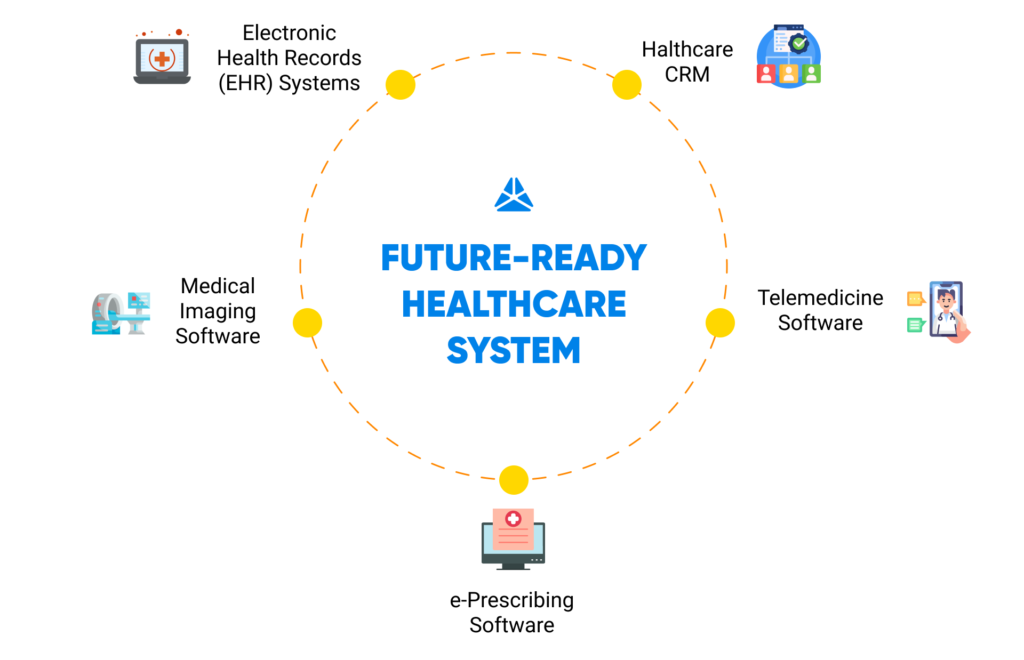
Electronic Health Records (EHR) System
IT outsourcing companies can help healthcare providers customize and implement electronic health records (EHR) to meet their specific needs and workflows. This can help ensure that the EHR system is optimized for the organization’s unique requirements and can be implemented efficiently and effectively. They also can help healthcare providers to migrate data from legacy systems to new EHR systems, ensuring that data is accurate, complete, and secure.
IT outsourcing companies help to develop features that enable the capture, management, and exchange of patient health information in a digital format. Namely:
- System implementation and customization: Outsourcing the implementation and customization of EHR systems can help healthcare providers ensure that the system is set up correctly and meets their specific needs.
- System maintenance and updates: Outsourcing can help ensure that the EHR system is always up-to-date and functioning properly.
- Data migration and medical device integration: Outsourcing data migration and integration can help healthcare providers transfer data from existing systems to the new EHR system and ensure seamless integration with other healthcare systems.
- User support and training: Outsourcing user support and training can help healthcare providers ensure that their staff is properly trained to use the EHR system and can provide technical support to resolve any issues that may arise.
- Security and regulatory healthcare compliance.
In addition, IT outsourcing companies provide ongoing support and maintenance for EHR systems and help healthcare providers ensure that their EHR systems are compliant with regulations such as HIPAA. All this leads to cost reduction of EHR system development, customization, and support.
CRM Tailored for Healthcare
Healthcare CRM systems can help medical organizations communicate with patients efficiently and effectively, through multiple channels such as email, text, or phone. This can help healthcare providers keep patients informed about their health status, appointments, and other important information.
CRM is a sophisticated technological solution which requires ongoing supervision and instruction during development.
Features of healthcare CRM that are typically outsourced include:
- Patient database management
- Appointment scheduling settings
- Patient feedback management
- Healthcare analytics and reporting
- Integration with other healthcare systems such as EHRs, billing systems, and patient portals, to provide a seamless patient experience
IT outsourcing companies can help healthcare providers implement a healthcare CRM system more efficiently. This can lead to an enhanced patient experience and improved patient satisfaction.
Telemedicine Software
Telemedicine software can help healthcare providers to reach patients who might not have access to traditional in-person care, such as those in remote or underserved areas. Telemedicine software can help healthcare providers to communicate with patients efficiently and effectively, through video conferencing, messaging, or other channels.
Telemedicine software development and maintenance are often outsourced to specialized companies.
IT outsourcing companies can help healthcare providers to implement telemedicine software that is easy to use and accessible to patients across multiple devices and platforms and includes other features like:
- Video conferencing: The development and integration of reliable and secure video conferencing tools require specialized expertise.
- Patient data management: Outsourcing this feature allows for more effective management of patient data.
- Remote monitoring: The development and integration of this feature often requires specialized hardware and software.
- Payment processing: Outsourcing this feature can help ensure secure and efficient payment processing.
- Medical device integration with other healthcare systems such as electronic health records (EHRs), billing systems, and appointment scheduling tools.
- Regulatory compliance
- User support
Medical Imaging Software
Medical imaging software can help healthcare providers to improve patient outcomes by enabling them to diagnose and treat patients more accurately and efficiently.
Medical imaging software must have sophisticated algorithms and tools for analyzing medical images accurately. Also, Medical Imaging Software must comply with various regulations, including HIPAA regulations for the protection of patient data. Outsourcing the development of these features can provide access to specialized expertise in image analysis.
Other features of Medical Imaging Software that are typically outsourced include:
- Integration with other healthcare systems such as electronic health records (EHRs) and Picture Archiving and Communication Systems (PACS).
- Image storage and management
- User support
- Customization and scalability: Medical Imaging Software may need to be customized and scaled to meet the specific needs of a healthcare provider. Outsourcing the development of these features can provide access to specialized expertise in customization and scalability.
- Training and education: Medical Imaging Software requires training and education to ensure that users can use the software effectively. Outsourcing this feature can provide access to specialized expertise in training and education.
e-Prescribing Software
e-Prescribing software can help healthcare providers to streamline their workflow by enabling them to create and transmit prescriptions electronically. Patient safety can also benefit from e-Prescribing software as the latter can reduce medication errors and adverse drug interactions.
E-prescribing software relies on comprehensive prescription drug databases to identify potential drug interactions and allergies. Outsourcing the development and integration of these databases can ensure accurate and up-to-date information. Speaking of regulation. E-prescribing software must comply with various, including DEA regulations for the electronic prescribing of controlled substances.
E-prescribing software should also include patient education and adherence tools to help patients understand their medications and follow their prescribed regimens. Outsourcing this and other features can ensure that e-prescribing software meets all necessary regulatory requirements.
6 Things to Consider When Choosing a Healthcare IT Outsource Provider
Outsourcing introduces cost-effectiveness to the development process; however, strong development skills are not enough to create complex medical solutions. Your partner should have a much wider background.
- An experienced outsourcing development provider should be able to help healthcare companies to implement and maintain effective medical software and, when the need arises, also provide customization of medical solutions to meet the specific needs that may come up.
- Those who work with healthcare for many years like MWDN, understand the complex regulatory requirements that healthcare providers must comply with, and can ensure that healthcare software solutions meet all necessary regulatory requirements.
- Experienced outsourcing development providers can ensure that medical software solutions are designed with robust healthcare data management measures to protect patient information from cyber threats.
With many successful projects behind our belt, NICAS CS is one of the most vivid examples of successful implementation of imaging software that supports all of the above-mentioned features. NICaS for NIMedical is a complex and sophisticated solution for noninvasive assessment and monitoring of different parameters. The system is written on .Net C# WPF 4,5 as it proves to be the best option in crafting complex systems for peculiar needs. - Our QA team conducts numerous testing of the system to make sure that it works smoothly, and delivers correct and precise results and it’s a must working on the healthcare solution.
- During the development of most medical systems, it is also worth considering that the system was simple and clear to use and had simple and intuitive navigation. All of this is taken into account with the solutions that our developers work on – all of them have a simple yet elegant design that nicely organizes all the complex information that healthcare solutions typically include.
- Advanced healthcare outsourcing providers today can offer more sophisticated collaboration work than traditional outsourcing does. For example, outstaffing providers also grant access to an international pool of talents, but at the same time, allow customers to participate in the candidate selection process to find the most suitable fit for the project. In outstaffing, the customer directly communicates with the team, sets its workload, and manages a team to achieve results in line with business objectives.
Partner With MWDN to Make Your Medical Facility Future-Ready
MWDN is a recognized provider of outstaffing services in various markets. However, healthcare has been our main focus for the past 20 years. We have over 200 sophisticated technological solutions that improve communication in medical institutions, contributing to saving human lives.
We foster digital transformation in healthcare among our clients who have trusted us with their services and solutions for many years. Partnering with our company can help your medical facility deliver next-level patient services with access to our specialized expertise, ensuring regulatory healthcare compliance, robust data security, and cost-effectiveness.
As a result, 100% of our customers keep up with the ever-changing market demands with the smart outstaffing model. Most of them report at least 60% of their labor costs and stay competitive in a highly competitive industry. We believe in the power of healthcare technology to enhance the quality of patient care and the efficiency of healthcare operations. Contact us to make your medical facility future-ready.
